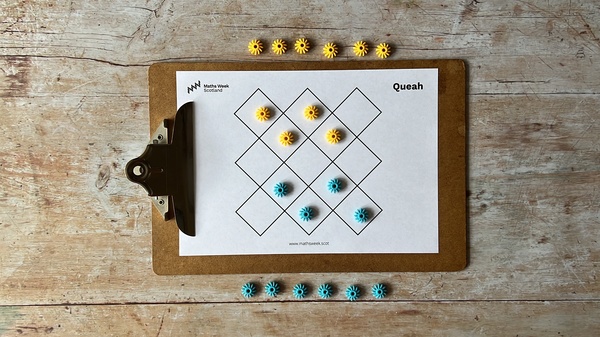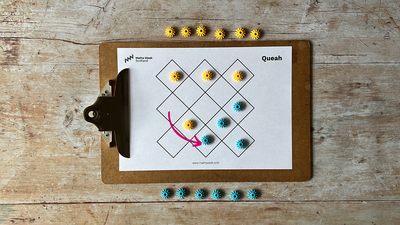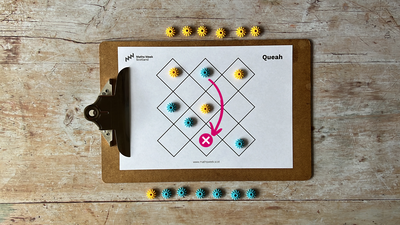Strategy Games: How to Play Queah

Queah is a traditional board game from Liberia. The two-player strategy game has some similarities to draughts, in that you capture your opponent's counters by jumping over them. A unique feature is that you have a reserve, from which you can replace your captured counters.
You Will Need
- 2 players
- A game board - draw out a copy of the grid in the pictures below, or download a copy of our board
- 10 counters per player in two different colours or shapes, e.g. beads or buttons
If you are playing this game outside, you can also draw out a grid with chalk, or in the sand if you are at the beach. You can use natural materials, such as pebbles and pine cones, or two different kinds of shells, for the playing pieces.
Setting Up
The game is played on a grid of 13 squares, set up in a diamond pattern in rows of 3-2-3-2-3.
Each player places four of their counters on their side of the board, as per the photograph below:

Players keep their remaining six counters next to them at the side of the board as a reserve.
How to Play
The aim of the game is to capture all your opponent's counters. The first player to do so, wins the game.
Players take it in turn to move one of their counters on the board. A counter can move to an adjacent empty square it shares a side with. You can only move one square per turn.
In this example, the blue counter has two options for moving. It cannot move to either of the other two adjacent empty squares, as only the corners are touching, not the sides.

Alternatively, you can capture one of your opponent's counters by jumping over it, if the square beyond it is empty. The direction of movement permitted is the same as above. In this example, blue can capture yellow because the squares are side by side.


However, in this example, blue can NOT capture yellow because the squares are corner to corner.

On your turn, if it is possible to take one of your opponent’s counters then you must do so. You can only capture one of your opponent's counters per turn. If more than one capture is possible, you can chose which capture to make. Counters are captured by jumping over them - as above - and they are then removed from the board for the rest of the game.
If a player's counter is captured, on their next turn they take a counter from their reserve and place it on any empty square of their choice. The placement of the reserve counter is their entire turn.
A player must always restore their counters on the board to four, if one of them is captured, unless they have none left in their reserve. If you have used up all your reserves, then you continue to play with what's on the board.
Game End
The game ends when one player captures their opponent's last counter.
Here it is blue's turn, but both of the squares blue can move to will lead to yellow being able to capture it on their next turn. Therefore, yellow will win the game.

Variations
Various online sources differ in the rules of the game, for example:
- Capturing your opponent's counter is optional, not mandatory.
- Replacing a captured counter happens at the start of your turn in addition to moving or capturing, not instead of it.
How would these variations affect your game play strategy?
You could also try adding your own variations, e.g. that you cannot move a counter immediately back to where you moved it from on your previous turn. This avoids a stale mate, where players just move their counters back and forth in the same spots to avoid capture.
Maths skills involved: spatial reasoning, logical deduction
Latest News and Events

Maths Week 2026: Maths Matters
Maths Week Scotland is back for 2026 with the theme Maths Matters. To celebrate our tenth year, we will have an extended gala week running over two weekends, from Saturday 19 to Sunday 27 September.

RSPB Big Schools' Birdwatch
It is almost time for the RSPB Big Schools’ Bird Watch – the largest citizen science project for schools across the UK. Sign up to take part, from 6th January- 13th February 2026.
